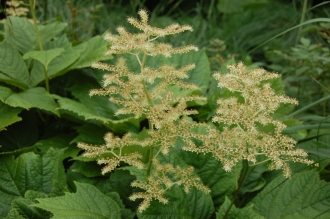Position: Full sun to partial shade
Flowering period: Summer
Soil: Moist, well drained
Eventual Height: 1.2m (flower spike 2m)
Eventual Spread: 1m
Hardiness: 5a, 5b, 6a, 6b, 7a, 7b, 8a, 8b, 9a
Family: Saxifragaceae
Rodgersia aesculifolia is a deciduous herbaceous perennial with a clump forming habit. Its mid green glossy leaves are deeply palmate with up to 9 leaflets. Its leaflets are obovate with doubly serrate margins, deeply veined up to 30cm long and 12cm broad. Its white/ pink flowers appears as a terminal open panicle above its leaves and are up to 60cm in length. Its roots are fleshy rhizomes which aids its slow spread.
Rodgersia aesculifolia, commonly known as the Horse Chestnut Rodgersia or Fingerleaf Rodgersia, is native to north China. In its native habitat it grows in moist woods edges, scrub and damp meadows.
The etymological root of the binomial name Rodgersia is named after Rear Admiral John Rodgers (1812 – 1882), an expedition commander of the US Navy. Aesculifolia is derived from the Latin Aesculus (the Horse Chestnut tree) and folium meaning ‘leaf’.
The landscape architect may find Rodgersia aesculifolia useful as an effective dramatic ground cover next to lakes, ponds and boggy areas. It likes wet but not waterlogged soils.
Ecologically, Rodgersia aesculifolia flowers are attractive to pollinating insects.
The Royal Horticultural Society has given Rodgersia aesculifolia their prestigious Award of Garden Merit in 1993.
Rodgersia aesculifolia prefers moist, humus rich, well-drained soils. It tolerates most pH of soil. It will tolerate wet soils. It dislikes dry soils.
Rodgersia aesculifolia requires little maintenance. Large clumps may be divided in spring.







